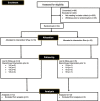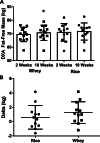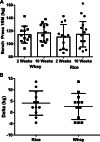Effects of daily 24-gram doses of rice or whey protein on resistance training adaptations in trained males
- PMID: 33261645
- PMCID: PMC7706190
- DOI: 10.1186/s12970-020-00394-1
Effects of daily 24-gram doses of rice or whey protein on resistance training adaptations in trained males
Abstract
Background: Large (48-g), isonitrogenous doses of rice and whey protein have previously been shown to stimulate similar adaptations to resistance training, but the impact of consuming smaller doses has yet to be compared. We evaluated the ability of 24-g doses of rice or whey protein concentrate to augment adaptations following 8 weeks of resistance training.
Methods: Healthy resistance-trained males (n = 24, 32.8 ± 6.7 years, 179.3 ± 8.5 cm, 87.4 ± 8.5 kg, 27.2 ± 1.9 kg/m2, 27.8 ± 6.0% fat) were randomly assigned and matched according to fat-free mass to consume 24-g doses of rice (n = 12, Growing Naturals, LLC) or whey (n = 12, NutraBio Labs, Inc.) protein concentrate for 8 weeks while completing a standardized resistance training program. Body composition (DXA), muscular strength (one-repetition maximum [1RM]) and endurance (repetitions to fatigue [RTF] at 80% 1RM) using bench press (BP) and leg press (LP) exercises along with anaerobic capacity (Wingate) were assessed before and after the intervention. Subjects were asked to maintain regular dietary habits and record dietary intake every 2 weeks. Outcomes were assessed using 2 × 2 mixed (group x time) factorial ANOVA with repeated measures on time and independent samples t-tests using the change scores from baseline. A p-value of 0.05 and 95% confidence intervals on the changes between groups were used to determine outcomes.
Results: No baseline differences (p > 0.05) were found for key body composition and performance outcomes. No changes (p > 0.05) in dietary status occurred within or between groups (34 ± 4 kcal/kg/day, 3.7 ± 0.77 g/kg/day, 1.31 ± 0.28 g/kg/day, 1.87 ± 0.23 g/kg/day) throughout the study for daily relative energy (34 ± 4 kcals/kg/day), carbohydrate (3.7 ± 0.77 g/kg/day), fat (1.31 ± 0.28 g/kg/day), and protein (1.87 ± 0.23 g/kg/day) intake. Significant main effects for time were revealed for body mass (p = 0.02), total body water (p = 0.01), lean mass (p = 0.008), fat-free mass (p = 0.007), BP 1RM (p = 0.02), BP volume (p = 0.04), and LP 1RM (p = 0.01). Changes between groups were similar for body mass (- 0.88, 2.03 kg, p = 0.42), fat-free mass (- 0.68, 1.99 kg, p = 0.32), lean mass (- 0.73, 1.91 kg, p = 0.37), fat mass (- 0.48, 1.02 kg, p = 0.46), and % fat (- 0.63, 0.71%, p = 0.90). No significant between group differences were seen for BP 1RM (- 13.8, 7.1 kg, p = 0.51), LP 1RM (- 38.8, 49.6 kg, p = 0.80), BP RTF (- 2.02, 0.35 reps, p = 0.16), LP RTF (- 1.7, 3.3 reps, p = 0.50), and Wingate peak power (- 72.5, 53.4 watts, p = 0.76) following the eight-week supplementation period.
Conclusions: Eight weeks of daily isonitrogenous 24-g doses of rice or whey protein in combination with an eight-week resistance training program led to similar changes in body composition and performance outcomes. Retroactively registered on as NCT04411173 .
Keywords: Body composition; Efficacy; Endurance; Fat-free mass; Performance; Plant proteins; Protein isolates; Protein source; Rice; Strength; Supplementation; Whey.
Conflict of interest statement
RJ is an inventor of patent WO2014138305 (US 9,820,504) and has not been involved in the data collection and analysis or writing the manuscript. All other authors declare no competing interests. All other authors declare no conflicts of interest.
Figures




Similar articles
-
The effects of protein and amino acid supplementation on performance and training adaptations during ten weeks of resistance training.J Strength Cond Res. 2006 Aug;20(3):643-53. J Strength Cond Res. 2006. PMID: 16937979 Clinical Trial.
-
The effects of whey protein with or without carbohydrates on resistance training adaptations.J Int Soc Sports Nutr. 2015 Dec 16;12:48. doi: 10.1186/s12970-015-0109-4. eCollection 2015. J Int Soc Sports Nutr. 2015. PMID: 26677350 Free PMC article. Clinical Trial.
-
The effects of phosphatidic acid supplementation on strength, body composition, muscular endurance, power, agility, and vertical jump in resistance trained men.J Int Soc Sports Nutr. 2016 Jun 2;13:24. doi: 10.1186/s12970-016-0135-x. eCollection 2016. J Int Soc Sports Nutr. 2016. PMID: 27274715 Free PMC article. Clinical Trial.
-
Effects of Milk Protein in Resistance Training-Induced Lean Mass Gains for Older Adults Aged ≥ 60 y: A Systematic Review and Meta-Analysis.Nutrients. 2021 Aug 17;13(8):2815. doi: 10.3390/nu13082815. Nutrients. 2021. PMID: 34444975 Free PMC article.
-
Achieving an Optimal Fat Loss Phase in Resistance-Trained Athletes: A Narrative Review.Nutrients. 2021 Sep 18;13(9):3255. doi: 10.3390/nu13093255. Nutrients. 2021. PMID: 34579132 Free PMC article. Review.
Cited by
-
Plant-Based Proteins, Peptides and Amino Acids in Food Products Dedicated for Sportspeople-A Narrative Review of the Literature.Nutrients. 2024 May 30;16(11):1706. doi: 10.3390/nu16111706. Nutrients. 2024. PMID: 38892638 Free PMC article. Review.
-
Plant Proteins and Exercise: What Role Can Plant Proteins Have in Promoting Adaptations to Exercise?Nutrients. 2021 Jun 7;13(6):1962. doi: 10.3390/nu13061962. Nutrients. 2021. PMID: 34200501 Free PMC article. Review.
-
The Effect of Plant-Based Protein Ingestion on Athletic Ability in Healthy People-A Bayesian Meta-Analysis with Systematic Review of Randomized Controlled Trials.Nutrients. 2024 Aug 17;16(16):2748. doi: 10.3390/nu16162748. Nutrients. 2024. PMID: 39203884 Free PMC article.
-
Dileucine ingestion, but not leucine, increases lower body strength and performance following resistance training: A double-blind, randomized, placebo-controlled trial.PLoS One. 2024 Dec 31;19(12):e0312997. doi: 10.1371/journal.pone.0312997. eCollection 2024. PLoS One. 2024. PMID: 39739679 Free PMC article. Clinical Trial.
-
Effect of Plant-Based Proteins on Recovery from Resistance Exercise-Induced Muscle Damage in Healthy Young Adults-A Systematic Review.Nutrients. 2025 Aug 7;17(15):2571. doi: 10.3390/nu17152571. Nutrients. 2025. PMID: 40806155 Free PMC article. Review.
References
-
- Trumbo P, Schlicker S, Yates AA, Poos M. Food, and nutrition Board of the Institute of medicine TNA. Dietary reference intakes for energy, carbohydrate, fiber, fat, fatty acids, cholesterol, protein and amino acids. J Am Diet Assoc. 2002;102(11):1621–1630. doi: 10.1016/S0002-8223(02)90346-9. - DOI - PubMed
-
- Jager R, Kerksick CM, Campbell BI, Cribb PJ, Wells SD, Skwiat TM, Purpura M, Ziegenfuss TN, Ferrando AA, Arent SM, Smith-Ryan AE, Stout JR, Arciero PJ, Ormsbee MJ, Taylor LW, Wilborn CD, Kalman DS, Kreider RB, Willoughby DS, Hoffman JR, Krzykowski JL, Antonio J. International society of sports nutrition position stand: Protein and exercise. J Int Soc Sports Nutr. 2017;14:20. doi: 10.1186/s12970-017-0177-8. - DOI - PMC - PubMed
-
- Biolo G, Maggi SP, Williams BD, Tipton KD, Wolfe RR. Increased rates of muscle protein turnover and amino acid transport after resistance exercise in humans. Am J Phys. 1995;268(3 Pt 1):E514–E520. - PubMed
Publication types
MeSH terms
Substances
Associated data
LinkOut - more resources
Full Text Sources
Medical
Research Materials
